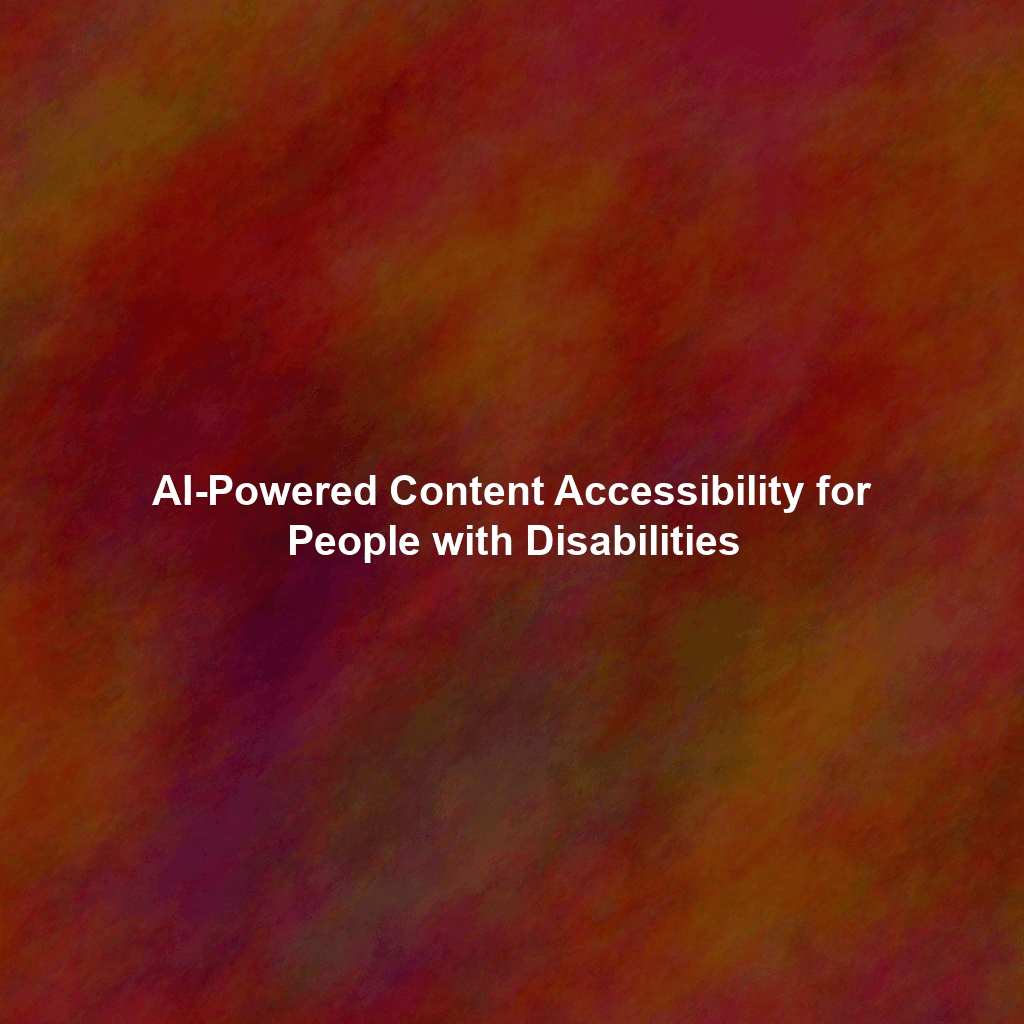Bridging the Digital Divide: How AI is Empowering Content Accessibility
The internet, for all its promise of connecting the world, can be a frustrating and isolating place for individuals with disabilities. Navigating websites, consuming digital content, and participating fully in the online experience often presents significant hurdles. These barriers stem from poorly designed websites, inaccessible content formats, and a general lack of awareness about accessibility best practices. However, a powerful ally is emerging: Artificial Intelligence (AI). AI is rapidly transforming content accessibility, promising a more inclusive and equitable digital landscape for everyone.
The Urgent Need for Accessible Content
Before diving into the specifics of AI’s role, it’s crucial to understand the scope of the accessibility challenge. Millions of people worldwide live with disabilities that impact their ability to interact with digital content. This includes:
- Visual impairments: Individuals who are blind, have low vision, or are colorblind.
- Auditory impairments: Individuals who are deaf or hard of hearing.
- Motor impairments: Individuals with limited dexterity or mobility who may have difficulty using a mouse or keyboard.
- Cognitive impairments: Individuals with learning disabilities, attention deficit disorders, or memory issues.
For these individuals, inaccessible content can mean being excluded from accessing vital information, educational resources, employment opportunities, and social connections. It’s not just a matter of convenience; it’s a matter of fundamental human rights.
AI to the Rescue: Transforming Content Accessibility
AI offers a range of innovative solutions to address the challenges of content accessibility. Here’s a look at some key applications:
1. Automated Alt-Text Generation
Alternative text (alt-text) is crucial for visually impaired users, as it provides a textual description of images that screen readers can read aloud. However, writing effective alt-text can be time-consuming and requires a degree of expertise. AI-powered alt-text generation tools analyze images and automatically create descriptive alt-text. While not perfect (human review is still recommended), these tools significantly reduce the burden on content creators and ensure that images are accessible to a wider audience. Sophisticated AI can even identify objects, scenes, and emotions within an image to provide more contextually relevant descriptions.
2. Real-Time Captioning and Transcription
Captions are essential for making video and audio content accessible to individuals who are deaf or hard of hearing. Traditional captioning methods often rely on manual transcription, which can be expensive and time-consuming. AI-powered speech-to-text technology is revolutionizing captioning by providing real-time captions for live events, webinars, and video conferences. These systems are constantly improving in accuracy and can even distinguish between different speakers and account for accents and dialects. Furthermore, AI can automatically generate transcripts of audio and video content, making it easier for users to search, navigate, and consume information in a format that suits their needs.
3. Text-to-Speech and Speech-to-Text Conversion
AI-powered text-to-speech (TTS) and speech-to-text (STT) technologies enable users to interact with content in the way that is most comfortable and effective for them. TTS allows users to listen to text content instead of reading it, which can be beneficial for individuals with visual impairments or learning disabilities. STT allows users to dictate text content instead of typing it, which can be helpful for individuals with motor impairments. These technologies are becoming increasingly sophisticated, with more natural-sounding voices and improved accuracy in speech recognition.
4. Automated Content Remediation
Many websites and documents contain accessibility errors that can make them difficult or impossible for people with disabilities to use. AI-powered content remediation tools can automatically identify and fix these errors, such as missing alt-text, improper heading structures, and insufficient color contrast. These tools can scan entire websites and documents, generating reports of accessibility issues and providing recommendations for how to resolve them. Some tools can even automatically correct certain types of errors, saving content creators significant time and effort.
5. Personalized Content Adaptation
One size doesn’t fit all when it comes to accessibility. People with different disabilities have different needs and preferences. AI can be used to personalize content based on individual user profiles. For example, a website could automatically adjust the font size, color contrast, and layout based on a user’s visual preferences. Or, it could provide alternative formats of content, such as simplified text versions for users with cognitive impairments. AI-powered personalization can create a more tailored and inclusive user experience for everyone.
6. Intelligent Accessibility Testing
Ensuring content is accessible requires rigorous testing. AI can assist in this process by automating many aspects of accessibility testing. AI-powered tools can crawl websites and analyze code to identify potential accessibility violations, such as insufficient color contrast, missing ARIA attributes, and improper keyboard navigation. These tools can generate detailed reports highlighting areas that need attention, allowing developers to focus their efforts on addressing the most critical issues. While not a replacement for manual testing by people with disabilities, AI-driven testing can significantly streamline the process and improve the overall accessibility of digital content.
The Benefits of AI-Powered Accessibility
Implementing AI-powered accessibility solutions offers a multitude of benefits, not only for people with disabilities but also for organizations and society as a whole:
- Improved User Experience: Accessible content is more usable and enjoyable for everyone, regardless of their abilities.
- Increased Reach: Making content accessible expands the audience to include people with disabilities, who represent a significant portion of the population.
- Enhanced SEO: Many accessibility best practices also improve SEO, as search engines prioritize websites that are user-friendly and well-structured.
- Legal Compliance: Many countries and regions have laws and regulations that require websites and digital content to be accessible.
- Brand Reputation: Demonstrating a commitment to accessibility enhances a company’s brand reputation and fosters a positive image.
- Increased Innovation: Focusing on accessibility often leads to new and innovative design solutions that benefit all users.
The Future of AI in Content Accessibility
AI is still in its early stages of development, and its potential for transforming content accessibility is immense. As AI technology continues to evolve, we can expect to see even more sophisticated and effective solutions emerge. Future advancements may include:
- More accurate and nuanced AI-powered alt-text generation.
- Improved real-time captioning with better speaker identification and context awareness.
- More personalized content adaptation based on individual user needs and preferences.
- AI-powered tools that can automatically generate accessible content from scratch.
- Seamless integration of accessibility features into all digital content creation platforms.
Challenges and Considerations
While AI offers tremendous potential for improving content accessibility, it’s important to acknowledge that it’s not a silver bullet. There are several challenges and considerations that need to be addressed:
- AI Bias: AI algorithms can be biased if they are trained on data that reflects existing societal biases. It’s crucial to ensure that AI systems used for accessibility are trained on diverse and representative data sets to avoid perpetuating inequalities.
- Over-Reliance on Automation: AI should be used to augment, not replace, human expertise. Human review is still essential to ensure that AI-generated content is accurate, appropriate, and meets the needs of all users.
- Ethical Considerations: It’s important to consider the ethical implications of using AI to make decisions about accessibility. For example, who is responsible if an AI-powered alt-text generator provides an inaccurate or offensive description of an image?
- Cost and Accessibility of AI Tools: Making sure AI-powered accessibility tools are themselves affordable and accessible is vital to prevent further digital divides.
Conclusion: A More Inclusive Digital Future
AI is revolutionizing content accessibility, paving the way for a more inclusive and equitable digital world. By automating tasks like alt-text generation, captioning, and content remediation, AI empowers content creators to build more accessible experiences for everyone. While challenges remain, the potential benefits of AI-powered accessibility are undeniable. By embracing AI and prioritizing accessibility, we can create a digital landscape where everyone can participate fully and thrive.
 Skip to content
Skip to content

